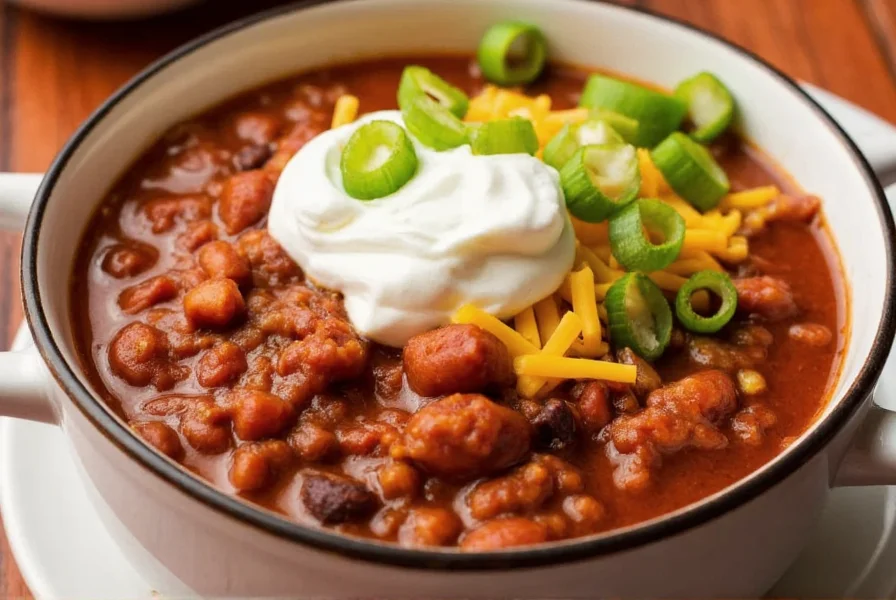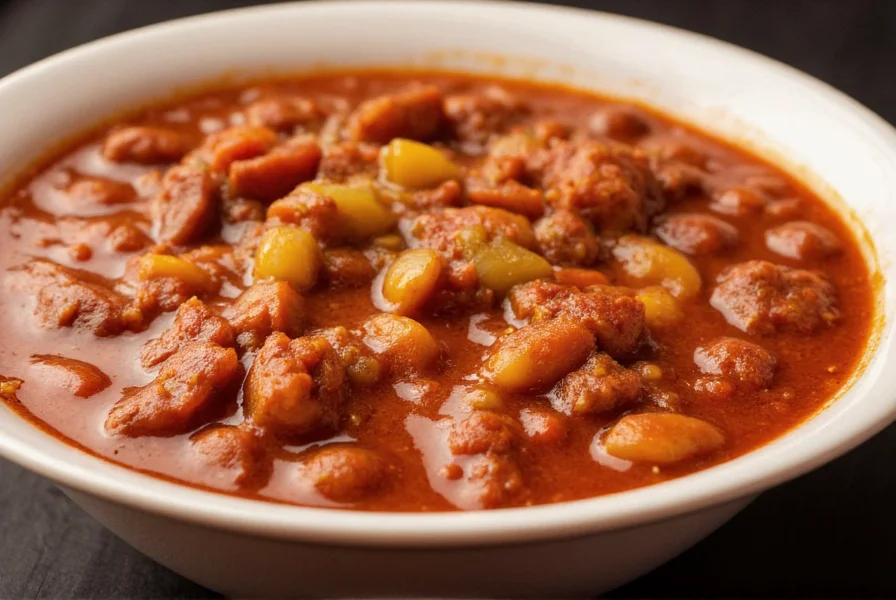A perfect chili recipe combines ground meat (typically beef), kidney beans, tomatoes, onions, garlic, and a balanced blend of spices including chili powder, cumin, and paprika. Simmered for 60-90 minutes, this hearty dish serves 6-8 people and requires approximately 20 minutes of preparation time. The key to exceptional chili lies in proper spice layering, meat browning technique, and sufficient simmering time to develop complex flavors.
The Ultimate Guide to Making Authentic, Flavor-Packed Chili
Chili stands as one of America's most beloved comfort foods, with regional variations spanning from Texas-style meat-only versions to Cincinnati's distinctive cinnamon-kissed interpretation. This comprehensive guide delivers a foolproof approach to creating deeply flavorful chili that balances heat, sweetness, and umami notes while accommodating various dietary preferences.
Essential Components of Exceptional Chili
Professional chefs consistently emphasize three critical elements that separate good chili from extraordinary chili: proper meat searing, strategic spice blooming, and adequate reduction time. Many home cooks make the mistake of dumping all ingredients into a pot simultaneously, which prevents flavor development.

Classic Beef Chili Recipe
This tested recipe serves 6-8 people and delivers restaurant-quality results with accessible ingredients. The preparation requires 20 minutes with 75 minutes of simmering time for optimal flavor development.
Ingredients
- 2 lbs ground chuck (80% lean)
- 1 large yellow onion, finely diced
- 4 cloves garlic, minced
- 1 red bell pepper, finely chopped
- 2 (15oz) cans kidney beans, drained and rinsed
- 1 (28oz) can crushed tomatoes
- 2 tbsp tomato paste
- 2 tbsp chili powder
- 1.5 tsp ground cumin
- 1 tsp smoked paprika
- 0.5 tsp cayenne pepper (adjust to taste)
- 1 tsp dried oregano
- 1 bay leaf
- 1 cup beef broth
- Salt and freshly ground black pepper to taste
Step-by-Step Preparation
- Proper meat browning: Heat 1 tbsp oil in a heavy-bottomed pot over medium-high heat. Add half the ground beef, breaking into small pieces. Allow to develop a deep brown crust (5-7 minutes) before stirring. Repeat with remaining beef.
- Spice blooming: Reduce heat to medium. Add onions, bell pepper, and garlic. Cook until softened (5 minutes). Stir in chili powder, cumin, paprika, and cayenne. Cook for 1 minute until fragrant.
- Building flavor layers: Add tomato paste, stirring constantly for 2 minutes. This caramelization step deepens flavor complexity.
- Simmering: Add crushed tomatoes, beans, oregano, bay leaf, and broth. Bring to gentle simmer, then reduce heat to low. Partially cover and cook for 60-90 minutes, stirring occasionally.
- Final seasoning: Remove bay leaf. Adjust salt, pepper, and acidity with 1 tsp vinegar if needed. For thicker chili, simmer uncovered for additional 15 minutes.
| Preparation Stage | Key Technique | Common Mistake to Avoid |
|---|---|---|
| Meat Browning | High heat, minimal stirring for crust development | Overcrowding the pot causing steaming instead of browning |
| Spice Integration | Dry spices cooked in fat for 60 seconds | Adding spices directly to liquid without blooming |
| Simmering Process | Gentle simmer, partially covered | Boiling vigorously causing ingredient breakdown |
Professional Tips for Elevated Chili
Mastering the best slow cooker chili recipe requires understanding these chef-recommended techniques:
- Meat selection: Use 80% lean ground chuck for optimal fat content. The fat carries flavor and creates richness. For authentic Texas chili recipe variations, consider using cubed chuck roast instead of ground beef.
- Spice customization: For mild chili recipe options, reduce cayenne to 1/4 tsp. For extra heat, add 1 diced jalapeño with the vegetables or 1/2 tsp chipotle powder.
- Flavor balancing: If your chili tastes too acidic, add 1/2 tsp baking soda. If too spicy, stir in 1 tbsp honey or maple syrup.
- Texture control: For thick chili recipe results without compromising flavor, remove 1 cup of chili, blend until smooth, then return to pot.

Variations for Different Dietary Needs
Adapting this basic chili recipe creates numerous delicious options:
- Vegetarian chili recipe: Substitute beef with 2 cups cooked lentils and 1 cup diced mushrooms. Use vegetable broth instead of beef broth.
- White chicken chili recipe: Replace beef with 2 lbs shredded cooked chicken. Use white beans instead of kidney beans and add 1 tbsp lime juice at the end.
- Instant Pot chili recipe: Brown meat using sauté function, then pressure cook on high for 15 minutes with natural release.
- Healthy chili recipe: Use lean ground turkey and increase vegetable content with additional diced carrots and zucchini.
Common Mistakes That Ruin Chili
Avoid these frequent errors when preparing your easy chili recipe:
- Insufficient simmer time: Rushing the cooking process prevents flavor development. Authentic chili requires minimum 60 minutes of gentle simmering.
- Over-reliance on canned chili powder: Many commercial blends contain excessive salt and fillers. Create your own blend using pure spices for better control.
- Adding beans too early: Beans added at the beginning can become mushy. For best results in your homemade chili recipe, add them halfway through cooking.
- Skipping the acid balance: A small splash of vinegar or citrus juice at the end brightens flavors and balances richness.
Serving and Storage Recommendations
For optimal enjoyment of your perfect chili recipe, serve hot with these traditional toppings:
- Freshly shredded cheddar or Monterey Jack cheese
- Sour cream or Greek yogurt
- Chopped green onions or fresh cilantro
- Crushed tortilla chips for texture contrast
Store leftovers in an airtight container in the refrigerator for up to 5 days or freeze for up to 3 months. Chili often tastes even better the next day as flavors continue to meld.
Frequently Asked Questions
How can I make my chili less spicy without losing flavor?
Add dairy products like sour cream or shredded cheese when serving, which neutralize capsaicin. During cooking, incorporate 1-2 tbsp of honey or maple syrup to balance heat. For future batches, reduce cayenne pepper and rely more on smoked paprika for depth without excessive heat. Adding extra beans or tomatoes can also dilute spiciness while maintaining volume.
What's the difference between chili con carne and regular chili?
Authentic chili con carne ("chili with meat" in Spanish) traditionally contains only meat, chili peppers, and spices—no beans. Texas-style chili follows this tradition, while many regional American variations include beans, tomatoes, and additional vegetables. The term "chili" alone typically refers to the bean-containing version popular across most of the United States.
Can I make chili ahead of time for a party?
Absolutely. Chili actually improves when made 1-2 days in advance as flavors continue to develop. Prepare it fully, then cool and refrigerate. When reheating, add a splash of broth or water as needed since chili thickens when stored. For large gatherings, consider preparing it in a slow cooker on warm setting to maintain temperature without overcooking.
Why does my chili taste bland even with all the spices?
Bland chili typically results from improper spice handling. Spices must be bloomed in fat (like oil or meat drippings) for 30-60 seconds before adding liquids to release their essential oils. Additionally, insufficient salt or lack of acid balance (try 1 tsp vinegar at the end) can make flavors seem flat. Always season in layers—salt the meat while browning, then adjust at the end.











 浙公网安备
33010002000092号
浙公网安备
33010002000092号 浙B2-20120091-4
浙B2-20120091-4